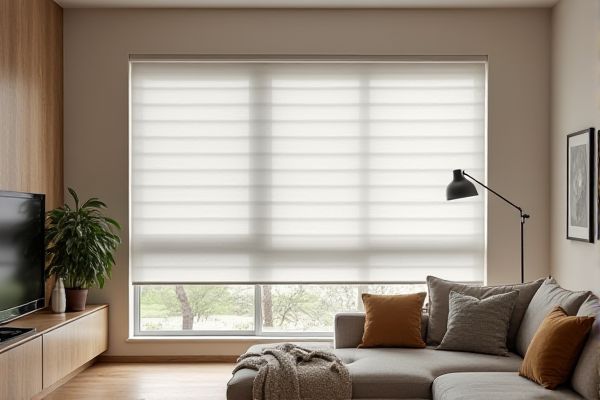
Motorized blinds offer effortless control and enhanced convenience through remote or smart home integration, while manual blinds provide a cost-effective and simple solution without the need for power sources. Discover which option best fits your lifestyle and home's needs by reading the rest of the article.
Table of Comparison
| Feature | Motorized Blinds | Manual Blinds |
|---|---|---|
| Operation | Remote control, automated schedules, app integration | Manual pull cords or wand |
| Convenience | High - hands-free, voice control options | Low - requires physical effort |
| Installation | More complex, requires wiring or batteries | Simple, no electrical setup needed |
| Cost | Higher initial investment, potential energy savings | Lower upfront cost |
| Maintenance | Regular checks on motors and batteries | Minimal maintenance |
| Durability | Dependent on motor quality, sensitive to electrical faults | Generally robust and long-lasting |
| Automation & Smart Home Integration | Supports smart home systems (Alexa, Google Home) | Not compatible with smart home devices |
Introduction to Motorized vs Manual Blinds
Motorized blinds offer automated control through remote devices or smart home integration, providing convenience and precise adjustment of light and privacy. Manual blinds require physical operation, typically using cords, wands, or clips, which can be less efficient for large or hard-to-reach windows. Choosing motorized blinds enhances your home's functionality and energy efficiency, while manual blinds remain a cost-effective and simple solution.
Overview of Motorized Blinds
Motorized blinds offer automated control through remote, smartphone apps, or voice commands, enhancing convenience and energy efficiency in modern homes and offices. These blinds are equipped with built-in motors and smart technology, allowing precise adjustments to light and privacy settings. Integration with smart home systems like Amazon Alexa, Google Home, or Apple HomeKit provides seamless automation, improving user experience and accessibility compared to traditional manual blinds.
Key Features of Manual Blinds
Manual blinds offer precise control through readily accessible cords, wands, or slats that allow users to adjust light and privacy easily. Their straightforward mechanism ensures lower cost, simpler installation, and minimal maintenance compared to motorized options. Manual blinds are favored for their reliability, durability, and ability to function without electricity or complex technology.
Installation Process Comparison
Motorized blinds feature a more complex installation process, often requiring electrical wiring or battery setup, while manual blinds are simpler to install with standard mounting brackets and minimal tools. Professional installation for motorized blinds ensures proper integration with your home automation system and smooth operation, whereas manual blinds can typically be installed by homeowners within minutes. Your choice depends on your preference for convenience and readiness to invest in a more advanced setup versus straightforward installation.
Convenience and Ease of Use
Motorized blinds offer unparalleled convenience through remote control and programmable settings, allowing users to adjust lighting with minimal effort. Manual blinds require physical handling, which can be cumbersome for large or hard-to-reach windows. Automated systems enhance accessibility and save time, proving especially beneficial for individuals with mobility challenges.
Energy Efficiency and Smart Home Integration
Motorized blinds offer superior energy efficiency by automatically adjusting to sunlight and temperature, reducing heating and cooling costs in your home. They integrate seamlessly with smart home systems, allowing you to schedule and control blinds remotely through voice commands or smartphone apps. Your manual blinds lack these automation features, making motorized options ideal for enhancing both energy savings and smart home convenience.
Cost Comparison: Upfront and Long-Term
Motorized blinds have a higher upfront cost due to advanced technology and installation requirements, often ranging from $200 to $500 per window compared to $50 to $150 for manual blinds. Over the long term, motorized blinds can offer energy savings and increased durability, potentially reducing utility bills and maintenance costs, whereas manual blinds may incur less initial expense but lack these benefits. Your choice depends on balancing upfront investment with long-term efficiency and convenience.
Maintenance and Durability
Motorized blinds generally require less frequent maintenance due to automated controls reducing mechanical wear, while manual blinds often need regular adjustments and lubrication to maintain smooth operation. The durability of motorized blinds tends to be higher, supported by robust electronic components and high-quality materials designed for long-term use. Manual blinds are more prone to damage from repeated physical handling, which can lead to faster wear and tear over time.
Aesthetics and Design Flexibility
Motorized blinds offer sleek, modern aesthetics with seamless integration into smart home systems, providing clean lines and a minimalist appearance that complements contemporary interiors. Manual blinds, while available in various styles and materials, often require visible cords or wands that can disrupt the design flow and limit customization options. Design flexibility is enhanced in motorized blinds through programmable settings and remote control, allowing precise adjustment of light and privacy without compromising style.
Which Blinds Are Right for You?
Motorized blinds offer enhanced convenience and precise control, ideal for smart home integration and hard-to-reach windows, while manual blinds provide a cost-effective, straightforward option with easy installation. Consider factors such as budget, lifestyle, accessibility needs, and technology preferences when choosing between the two. Evaluate your priorities on automation, maintenance, and energy efficiency to determine the best fit for your space.
 homyna.com
homyna.com